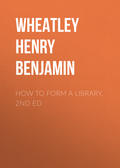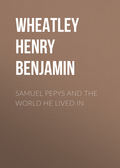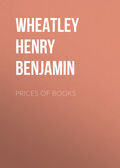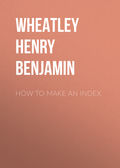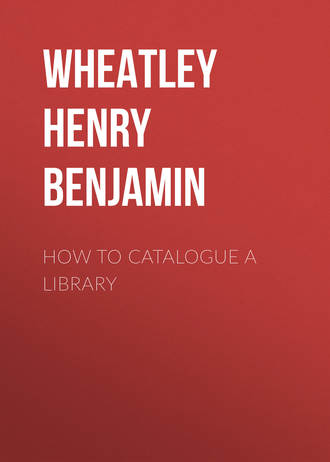
Wheatley Henry Benjamin
How to Catalogue a Library
CHAPTER III.
PRINT v. MANUSCRIPT
There has been much discussion on the relative advantages of Print and Manuscript. Panizzi's objection to print was a sound one, as he considered that no titles should be printed until the catalogue of the whole library was completed. When this time came the objection was no longer valid, and arrangements were made in due course for printing the catalogue by instalments. Before this was decided upon there were some who insisted upon the actual superiority of manuscript over print; but this was really absurd, because, if the extra cost of printing can be defrayed, there must be great advantage in the clearness and legibility of print, as well as in the saving of space caused by its use.
Mr. Parry, with his strong common sense, advocated, in 1849, the use of the printing-press. He said in his evidence: "I think the Catalogue ought to be printed; not merely for the purposes of the library, and of reference out of the library, but also because I think the Catalogue of this library is a work that ought to be in every public institution where men of letters resort, either here, on the Continent, in America, or in any other part of the civilized world; still, it ought not to be printed until the whole of the books are catalogued up to a certain time. I say 'up to a certain time' because the whole of the books never can be catalogued in a library where there are constant accessions. But a limit may be fixed, and when that limit is reached and the whole of the books within that limit are catalogued I would then print the Catalogue, and not before. I have said before that the volume of letter A must be cancelled; that is inevitable. Nobody after this Catalogue is completed, no librarian, no man of the most ordinary literary acquirements, would presume to print the Catalogue without cancelling this volume: that arises from the circumstance that, as the cataloguing goes on, thousands of works will turn up as necessary to be inserted in letter A."16
Mr. Parry added, that in ordering this partial printing the trustees gave way to pressure from without, which he defined very justly as "a sort of ignorant impatience for a catalogue by persons who do not really understand what a catalogue is or what a catalogue should be."
Dr. Garnett read a very interesting paper on "The Printing of the British Museum Catalogue," before the Library Association, at the Cambridge meeting, in 1882, in which he tells how the present system of printing came about.
Mr. Rye, when Keeper of the Printed Books, strongly urged the adoption of print; but Dr. Garnett adds, "Other views, however, prevailed for the time; and when, in October 1875, the subject was again brought forward by the Treasury it fell to my lot to treat it from a new point of view, suggested by my observations in my capacity as superintendent of the reading-room. I saw that, waiving the question as to the advantage or disadvantage of print in the abstract, it would soon be necessary to resort to it for the sake of economy of space. There were by this time two thousand volumes of manuscript catalogue in the reading-room, exclusive of the catalogues of maps and music. There would be three thousand by the time that the incorporation of the general and supplementary catalogues was complete. Hundreds of these volumes in the earlier letters of the alphabet were already swollen with entries, and required to be broken up and divided into three. Sooner or later every volume would have undergone this process. By that time there would be nine thousand volumes of manuscript catalogue, three times as many as the reading-room could contain, or the public conveniently consult. The only remedy was to put a check upon the growth of the catalogue by printing all new entries for the future, and to mature meanwhile a plan for converting the entire catalogue into a printed one. I prepared a memorandum embodying these ideas, and entered into the subject more fully, when, in January 1878, it was again brought forward by the Treasury. These views, however, did not find acceptance at the time.... The question was thus left for Mr. Bond, who became Principal Librarian in the following August. As Keeper of the Manuscripts, Mr. Bond's attention had never been officially drawn to the catalogue of printed books, but as a man of letters, he had formed an opinion respecting it; and I am able to state that he came to the principal librarianship as determined to bestow the boon of print upon the Catalogue and the public, as to effect the other great reforms that have signalized his administration."17
Dr. Garnett, near the end of his paper, said, "My aspiration is that the completion of the Museum Catalogue in print may coincide with the completion of the present century;" and I believe he still holds the opinion that this is possible and probable.
Mr. Cutter enters very fully into this question of Printed or Manuscript? in his elaborate article on "Library Catalogues" in the United States Report on Public Libraries, 1876 (pp. 552-56). The advantages of a printed catalogue he states under five heads: "(1) that it is in less danger of partial or total destruction than a manuscript volume or drawers of cards;" "(2) that it can be consulted out of the library;" "(3) that it can be consulted in other libraries;" "(4) that it is easier to read than the best manuscript volume, and very much easier to consult. A card presents to the eye only one title at a time, whereas a printed catalogue generally has all an author's works on a single page. Time and patience are lost in turning over cards, and it is not easy either to find the particular title that is wanted or to compare different titles and make a selection;" "(5) that several persons can consult it at once."
The disadvantages are stated by Mr. Cutter under three heads: "(1) that it is costly;" "(2) that a mistake once made is made for ever, whereas in a card catalogue a mistake in name or in classification or in copying the title can be corrected at any time;" "(3) it is out of date before it is published. As it cannot contain the newest books, the very ones most sought for, fresh supplements are continually needed, each of which causes an additional loss of time and patience to consulters. The average man will not look in over four places for a book; a few, very persevering or driven by a great need, will go as far as five or six. It becomes necessary therefore, if the catalogue is to be of any use, to print consolidated supplements every five years, and that is expensive."
Of the advantages the main one is No. 4, and of the disadvantages the only one of any importance is, it seems to me, No. 1.
As to disadvantage No. 2, it is more apparent than real. A mistake in print will of course remain for ever in the copies of the catalogue outside the library, but it can easily be corrected in the library copy either in manuscript or by reprinting the single title in which the mistake occurs. The card catalogue cannot be used outside the library, and the catalogue in the library can be as easily corrected whether it be printed and pasted down on pages or arranged on cards. The two are equal in this respect. Disadvantage 3 is the stock objection. But what does it really come to? He who consults the catalogue of a library away from that library knows that a given book is there if he finds it in the catalogue; but if it is not in the catalogue, he does not give up hope, but either visits the library or sends to know if the book he requires is in. He is no worse off in this case than if there had been no printed catalogue; and in the former case he is much better off. The library copy of the catalogue can be kept up as well in print as it can be in manuscript, and here at all events there will only be one alphabet. It will therefore be a question for the consulter alone whether it is better worth his while to consult several supplements than to go straight to the library. For the purposes of the library, it is quite unnecessary to reprint or consolidate your supplements, because your library copy of the catalogue will always be kept up to date. If the library is a lending one, the subscribers will probably insist upon having new catalogues, as the supplements become too numerous; but this is only an additional instance of the advantages of a printed catalogue.
A printed catalogue should never be added to in manuscript, as this causes the greatest confusion; and, moreover, it is not necessary. It is quite possible to keep up a catalogue in print for many years; and even when worn out, if the printed sheets have been kept, a working catalogue can be made up afresh without printing again. The plan adopted by my brother, the late Mr. B. R. Wheatley, is so simple, that it seems scarcely necessary to enlarge upon its merits; but as it has not been generally adopted, I may perhaps explain it here with advantage. It will be seen by the specimen on page 59, that each page of the library copy of the catalogue is divided in two. On the left-hand side is pasted down the catalogue as it exists at the time, and the right-hand side is left for additions. These additions may be printed as annual supplements, or they may be printed from time to time at short intervals on galley slips on one side only, without being made into pages. This can be done as suits the best convenience of all concerned; and it is just as easy to have the titles printed frequently as to have them copied for insertion in the library copy of the catalogue. The ruled columns are for the press-marks, and these are arranged on the outside of each column for purposes of symmetry. It is not advantageous, as a rule, to print the press-marks in the catalogue, although this is done in the case of the British Museum. There are two advantages in having two columns of type on one page. One is that there is a saving of space, and the other is that it is easier to keep the alphabet in perfect register if it becomes necessary to insert a page. However well arranged a library copy of a catalogue may be, it will probably become congested in some places before the whole catalogue requires readjustment. Now suppose each page contains only one column of print, and the left-hand page is left for additions. When both pages are full, and it is necessary to insert a leaf for fresh additions, it is clear that the correct order of the alphabet will be thrown out. But if there are two columns on each page, then the additional leaf will introduce no confusion; for the recto of the additional leaf will range with the verso of the old leaf, and the verso of the additional leaf with the recto of the next leaf in the book. The only difference will be that you will have to run your eye along four columns instead of two.18

The advantage of this plan is that the library catalogue can be actually kept up for any length of time without any reprinting. When the catalogue is filled up, and there is no room for any additions, the whole may be pasted down afresh as in the first instance, always presuming that copies of the catalogue and its supplements have been retained.
Sometimes the pasting down of the print is delegated to the binder; but it should be done either by the librarian himself, or at all events under his eye, for much judgment and knowledge are required for the proper leaving of spaces where the additions are likely to be the thickest.
Another advantage of this plan is that a practically new library catalogue may be made up from old printed catalogues. Some five-and-twenty years ago, the Athenæum Club possessed a worn-out catalogue of its library. Supplements were printed, and I laid down in one alphabet a catalogue of the whole, which has lasted to the present time, although I believe it is pretty well worn out now. There were certain difficulties to be overcome, for the catalogue and its supplements were not made on the same system.
Card catalogues have been strongly advocated by some, and they present many advantages if used while the catalogue is growing in completeness; but for use when the catalogue is completed they cannot compete in convenience with the plan just described. It takes much longer to look through a series of cards representing the works of a given author than it does to run the eye down a page of titles.19
Professor Otis Robinson, in his article on "College Library Administration" (United States Report on Public Libraries, p. 512), writes thus on the adoption of card catalogues in the United States:—
"In some of the largest libraries of the country the card system has been exclusively adopted. Several of them have no intention of printing any more catalogues in book form. In others cards are adopted for current accessions, with the expectation of printing supplements from them from time to time. I think the tendency of the smaller libraries is to adopt the former plan, keeping a manuscript card catalogue of books as they are added, without a thought of printing."
This system of cataloguing has not taken hold of the English mind, although it has been adopted at the Bodleian Library by Mr. Nicholson, and at the Guildhall Library. The growth of this fashion appears to me as something almost incomprehensible, and one can only ask why such a primitive mode of arrangement should be preferred to a book catalogue. I can scarcely imagine anything more maddening than a frequent reference to cards in a drawer; and my objection is not theoretical, but formed on a long course of fingering slips or cards. If the arrangement of the catalogue is constantly being altered, it may be convenient to have cards; but when a proper system has been settled at the beginning, this cannot be necessary. When additions only have to be considered, these can be inserted into the book catalogue, so that the catalogue may last for many years. The use of a duplicate set of titles on cards for use in arrangement, which can be arranged and rearranged as often as required, is quite another matter. This plan is adopted at the Bodleian.
Varieties of type help the eye to choose out what it requires, and there is much saving of time in consulting a good printed catalogue instead of a good manuscript one. This is not a matter of opinion merely, but can be proved at once by consulting the printed volumes of the British Museum Catalogue against the volumes still in manuscript.
Before the details of printing are finally settled it is well to pay particular attention to the typographical arrangement, as a catalogue will be all the more useful as it is well set out.
A very ingenious scheme for the stereotyping of catalogue titles was published by Mr. C. C. Jewett, Librarian of the Smithsonian Institution, in 1850.20
The mode of carrying out the plan is explained as follows:—
"1. The Smithsonian Institution to publish rules for the preparation of catalogues.
"2. To request other institutions intending to publish catalogues of their books to prepare them according to these rules, with a view to their being stereotyped under the direction of the Smithsonian Institution.
"3. The Smithsonian Institution to pay the whole extra expense of stereotyping, or such part thereof as may be agreed on.
"4. The stereotyped titles to remain the property of the Smithsonian Institution.
"5. Every library uniting in this plan to have the right of using all the titles in the possession of the Smithsonian Institution, as often as desired for the printing of its own catalogue by the Institution; paying only the expense of making up the pages, of the press work, and of distributing the titles to their proper places.
"6. The Smithsonian Institution to publish as soon as possible, and at stated intervals, general catalogues of all libraries coming into this system."
It is not necessary here to explain how the stereotyped slips were to be manufactured, as the explanation will be found in the original paper.
A scheme of an allied character was propounded by the late Mr. Henry Stevens, who read a very interesting and amusing paper before the Conference of Librarians in 1877 on "Photo-Bibliography; or, A Central Bibliographical Clearing House" (Transactions, pp. 70-81). Mr. Stevens wrote:—
"My notion is that every book, big and little, that is published, like every child, big and little, that is born, should be registered, without inquiry into its merits or character.... I ask the attention of this Conference of Librarians to a word on the necessity of cataloguing every book printed; the importance of printed card catalogues of old, rare, beautiful, and costly books, and how to make them on a co-operative or universal system, which, for lack of a better term, I shall for the present call 'photo-bibliography.' For carrying out this project a Central Bibliographical Bureau or Clearing House for Librarians is suggested."
The author goes on to say:—
"From the days of Hipparchus to the present time, the stars have been catalogued; and to-day every bird, beast, fish, shell, insect, and living thing, yea every tree, shrub, flower, rock, and gem, as they become known are scientifically, systematically, and intelligently named, described, and catalogued. In all these departments of human knowledge there is a well-ascertained and generally acknowledged system, which is dignified as a science."
But no such system of registering books has ever been attempted. The cure for this negligence is then suggested:—
"This isolation and waste of vain repetition, it is believed, is wholly unnecessary. There is no royal road, it has been said, to knowledge. He who would attain the goal must learn to labour and to wait, for knowledge is locked up mainly in books, appropriately termed works. There is, however, a short cut with a pass-key in universal or co-operative bibliography, a simple system of arrangement by which may be economized the labours of hundreds who are cataloguing over and over the same books."
Mr. Stevens's special contribution to this great object was the use of reduced photographs of the title-pages of rare and curious books. The adoption of this plan would help on vastly the study of bibliography.
The strong feeling as to the waste of time occupied in the constant repetition going on in cataloguing the same book in different libraries crops up again and again, and surely we shall in the end be able to elaborate some scheme which will meet such a universally felt want. Professor Robinson was one of the earliest to protest against this waste, and his attention was called to it when inspecting various card catalogues. He found similar cards being repeatedly reproduced, and he suggested that by some system of cooperation this waste of labour might be reduced (United States Report on Public Libraries, pp. 512-14).
Two practical suggestions have been made. One is that every publisher should place in each copy of each book issued by him a catalogue slip made upon a proper system which has been settled by competent authorities, so that there may be a satisfactory uniformity; and the other that each government should catalogue every work published in its country. The former plan is scarcely likely to be undertaken systematically by all publishers, but the latter one might be carried out in connection with the ratification of copyright privileges. Every publication should be registered, and a copy submitted at the registration office. A part of the business of this office should be to issue periodically proper catalogue slips of every work registered, on a settled plan that had been well thought out by experts. The authorities of Stationers' Hall ought long ago to have been instructed to issue lists of all the books registered there; and if they were not prepared to undertake the duties indicated by the new Registration Law, the office might possibly be transferred to the British Museum with advantage. If England initiated such a scheme, other nations would probably follow its lead. At present the Catalogue of the British Museum, as now published, to some extent fulfils the required conditions; but much that is published in Great Britain even escapes through the meshes of the Museum's widespread net.
However much printed catalogues may be superior to manuscript ones, the latter must always be used in a large number of cases, especially for private libraries; and therefore it may be well to say a few words here respecting the preparation and keeping up of a manuscript catalogue.
There are two ways of making and keeping up a new catalogue. The one is that adopted at the British Museum, which was suggested simultaneously by the Right Hon. J. Wilson Croker, and by Mr. Roy, one of the Assistant Librarians in the Printed Book Department. The catalogue slips are lightly pasted down into guarded volumes, the ends being left unpasted, so that the slips can easily be detached with the help of a paper-knife if it be needful at any time to change their position.
The other plan is to copy out fairly the titles on one side of sheets of paper, proper spaces being left, as well as the whole of the opposite page for additions. These sheets are afterwards bound into a volume or volumes. The former plan is the best for a large and a constantly increasing catalogue; but the latter plan is more satisfactory for an ordinary private library, as it forms a more shapable and better-looking volume. From experience it may be said that a catalogue of this kind, in which proper spaces have been left, will last for many years; and should it become congested in any one portion, it is quite easy to rewrite those pages on a larger scale, and have the volume rebound.

A specimen of how paper should be ruled for a manuscript catalogue made on the latter plan is given on page 72. The columns at the right-hand side of the paper, for size and date, add to the clearness of the catalogue, as well as making the page look neater. The most useful size is about 1 ft. 5 in. high by 11-1/2 in. wide—the size of Whatman's best drawing paper, which can be used with advantage.



